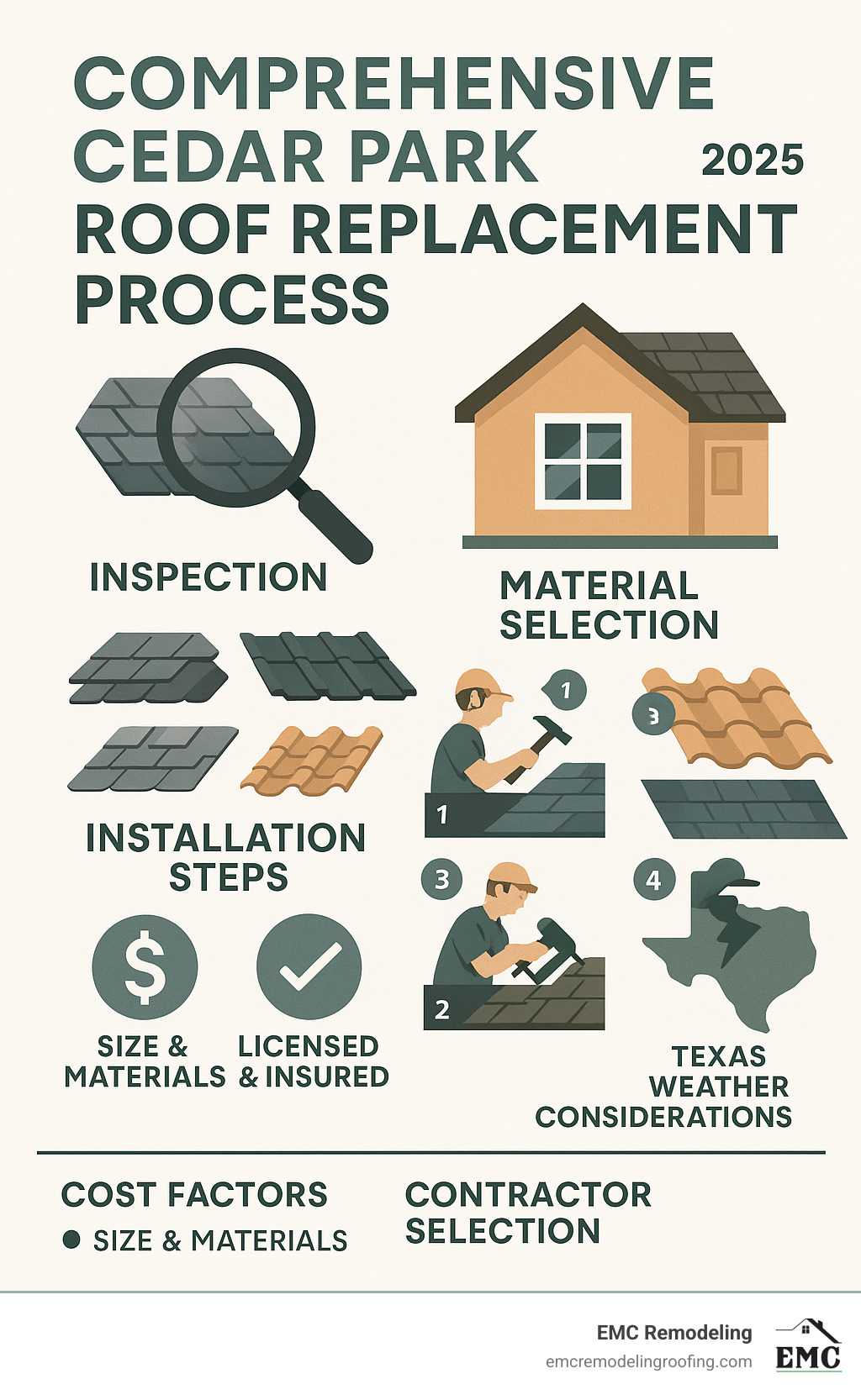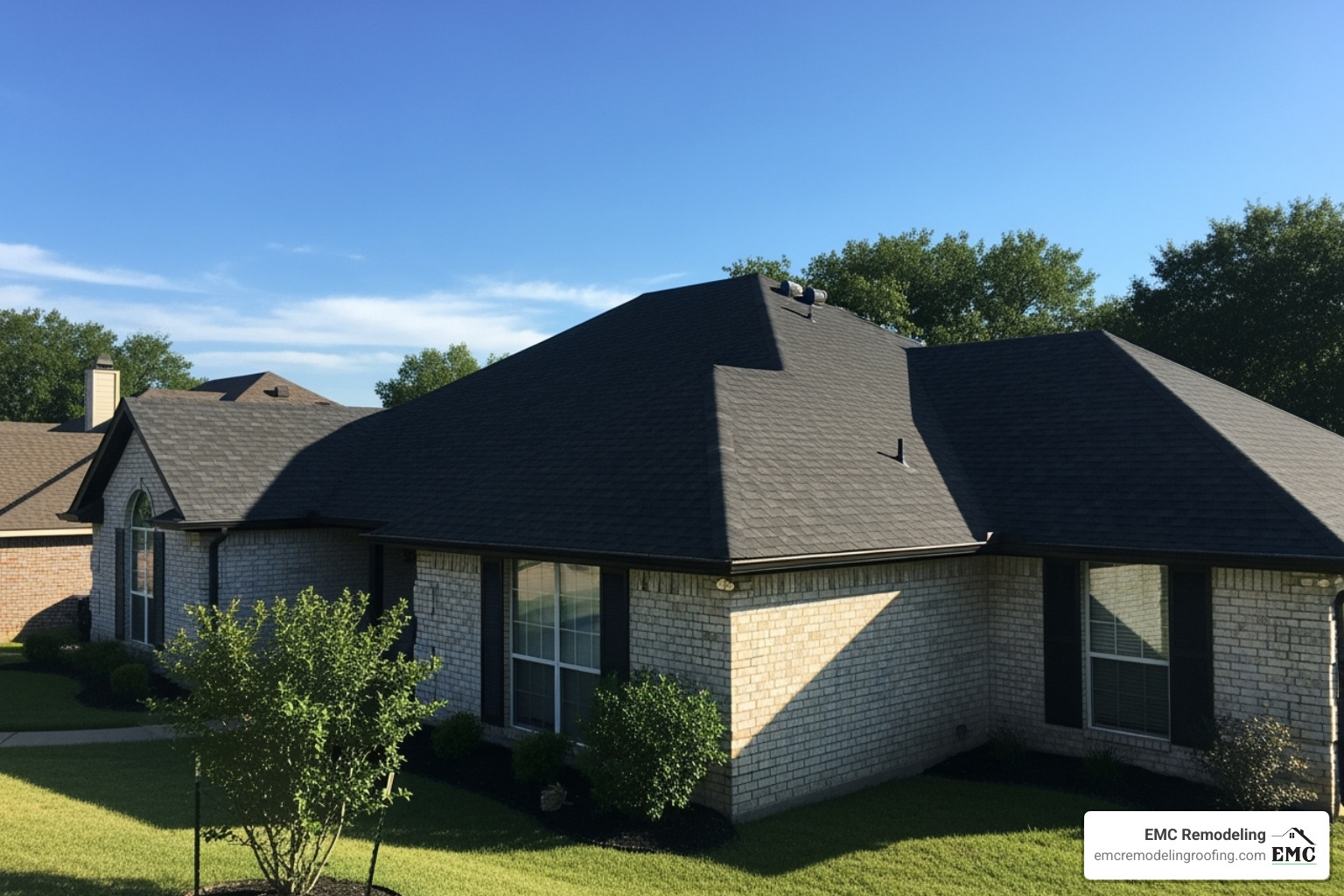Protecting Your Cedar Park Home
Cedar Park roof replacement is a critical investment for Central Texas homeowners. Our region’s intense sun, severe hail storms, and torrential rain can compromise even the most robust roofing systems. Whether you’re facing sudden storm damage, a roof reaching the end of its lifespan, or planning a home upgrade, understanding the replacement process is key to making informed decisions and protecting your property’s value. As a leading provider of comprehensive roofing solutions, we know that a quality roof is your home’s first line of defense.
Quick Guide to Cedar Park Roof Replacement:
- Average Cost: $6,000 – $10,000+ depending on size, pitch, and materials
- Best Materials: Asphalt shingles (affordable), metal roofing (durable), or tile (premium)
- Timeline: Most replacements take 2-3 days, weather permitting
- Top Local Contractors: Must be licensed, insured, and have extensive storm damage experience
- Permits Required: Yes, all work must be permitted through the City of Cedar Park
- Warranties: Look for both material (10-50 years) and workmanship (5-10 years) warranties
Your roof protects everything you value. In Cedar Park’s uniquely challenging climate, the right materials and a trusted contractor can mean the difference between a roof that lasts for decades and one that fails prematurely. Finding reliable residential roofing services near me is crucial when storm clouds gather or your current roof shows signs of wear. A qualified team will manage every detail, from the initial inspection and insurance claim assistance to the final cleanup, ensuring a smooth and stress-free process.
Why Cedar Park’s Climate Demands Quality Roofing
Texas weather is notoriously tough on roofs. Summer temperatures frequently soar above 100°F, causing materials to expand and bake under the UV radiation. This is often followed by severe thunderstorms that can bring golf-ball-sized hail, capable of destroying an entire roof in minutes. The rapid freeze-thaw cycles of a Central Texas winter add further stress, creating micro-fractures that can lead to leaks.
These extreme conditions mean that homeowners need a Cedar Park, TX roofer who understands how to build roofing systems that withstand nature’s onslaught while improving energy efficiency and curb appeal.
I’m Matthew Runyon, President of EMC Remodeling & Roofing. With over 15 years of experience helping Central Texas homeowners with Cedar Park roof replacement projects, I’ve seen what our weather can do. Our family-owned company has earned an A+ BBB rating by prioritizing quality workmanship, transparent communication, and complete customer satisfaction throughout every stage of the roof replacement process. We are your local experts, ready to help protect your home.
Your Local Roofing Partner
EMC Remodeling
5100 Midway Dr Suite 211, Temple, TX 76502
(254) 760-9268

Simple guide to Cedar Park roof replacement:
- corrugated garage roof replacement
- cost to replace underlayment on tile roof
- remove solar panels to replace roof
Is It Time for a New Roof? 7 Telltale Signs for Cedar Park Homeowners

Your roof rarely fails without warning—it sends out distress signals first. Learning to spot these signs can save you thousands in water damage repairs and help you plan your Cedar Park roof replacement before a minor issue becomes a major emergency.
Roof Age: The most significant factor is age. If your asphalt shingle roof is over 15 years old, it’s approaching the end of its effective lifespan. While manufacturers may rate them for 20-30 years, the intense Central Texas heat and frequent storms can shorten that timeline considerably.
Curling or Cracked Shingles: Take a walk around your property and look up. Are the edges of your shingles curling upwards, or do you see visible cracks and splits? This is a clear sign of weathering. As shingles age, they lose flexibility and become brittle, compromising their ability to keep water out.
Granules in Gutters: Check your gutters and downspouts. Finding an excessive amount of asphalt granules—the small, sand-like particles that coat your shingles—is a bad sign. These granules are the roof’s primary defense against UV radiation. When they wash away, it creates bald spots that leave the underlying material exposed to the sun, accelerating deterioration.
Water Stains and Leaks: Any sign of water intrusion inside your home is a red flag that demands immediate attention. Look for discoloration, stains, or peeling paint on ceilings and walls, especially in the attic. What appears as a small stain could indicate a much larger, hidden problem of trapped moisture, which can lead to structural rot and dangerous mold growth.
Sagging Roof Deck: A sagging or drooping roof is a critical emergency. If you notice any part of your roofline appearing bowed or uneven, it could signify a severe structural problem, often caused by prolonged water absorption in the roof decking. Do not wait—call a professional for an immediate inspection. This is a safety hazard that requires urgent action.
Frequent Repairs: Are you calling a roofer for fixes after every major storm? Constant patching is often a sign that the entire roofing system is failing. In the long run, the cumulative cost and stress of frequent repairs can exceed the expense of a complete replacement, which offers a permanent, warrantied solution.
Visible Storm Damage: Cedar Park is in the heart of “Hail Alley.” After any significant hailstorm or high-wind event, it’s wise to schedule a professional inspection. Hail can leave bruises or circular cracks on shingles, while strong winds can lift, tear, and remove them entirely, leaving your home vulnerable.
Our challenging climate accelerates this normal wear and tear. If you’re observing one or more of these warning signs, it’s time to explore your roof repair and replacement options. A thorough assessment from an experienced professional will clarify whether targeted repairs can suffice or if a full replacement is the most cost-effective and secure investment for your home.
Best Roofing Materials for Texas Heat and Storms
Choosing the right roofing material for your Cedar Park roof replacement can feel overwhelming, but it becomes much clearer when you focus on performance in the Texas climate. Our weather throws everything at a roof: scorching 100°F+ summers, destructive hail, high winds, and sudden temperature swings. Your chosen material must withstand this abuse while enhancing your home’s energy efficiency and curb appeal for years to come.
Let’s break down the three most popular options for Central Texas homes so you can make an informed decision for your budget and long-term goals.
| Material | Lifespan | Average Cost (per sq ft) | Hail Resistance | Energy Efficiency |
|---|---|---|---|---|
| Asphalt Shingles | 20-30 years | $3-$7 | Good to Excellent | Moderate |
| Metal Roofing | 50+ years | $8-$16 | Excellent | High |
| Tile/Slate | 100+ years | $12-$25 | Excellent | High |
Asphalt Shingles: The Affordable Standard
Asphalt shingles are the most common roofing material in Cedar Park, offering a fantastic balance of affordability, reliability, and style.
- Architectural Shingles: This is the premium choice in the asphalt category. They are thicker, heavier, and designed with a dimensional look that dramatically boosts curb appeal. Many architectural shingles are available in Class 4 impact-resistant varieties, specifically engineered to withstand hail damage, making them an excellent investment for our area. They typically come with 25-30 year warranties.
- 3-Tab Shingles: As a more basic option, 3-tab shingles have a flat, uniform appearance and a shorter lifespan (15-20 years). They are a viable choice for homeowners on a tight budget but offer less durability against wind and hail.
The versatility of asphalt is a major plus, with a vast array of colors to match any home style. Should damage occur, repairs are generally straightforward and cost-effective. For most Cedar Park families, high-quality architectural shingles provide the ideal blend of performance and value. Learn more about the composition of shingle roofs.
Metal Roofing: The Durable, Energy-Saving Choice
Metal roofing has surged in popularity across Texas, and for good reason. It offers a powerful combination of longevity, durability, and efficiency.
- Longevity and Durability: A properly installed metal roof can easily last 50 years or more with minimal maintenance. This often means it’s the last roof you’ll ever need to install. Its primary advantage in Cedar Park is superior hail resistance. While large hail may cause cosmetic denting, it rarely compromises the roof’s integrity, unlike shingles which can be shattered.
- Energy Savings: Metal roofs are highly reflective, bouncing solar heat away from your home instead of absorbing it. These “cool roofs” can significantly lower attic temperatures, reducing the strain on your air conditioning system and potentially cutting summer energy bills by 10-25%.
- Types and Investment: Options range from classic standing-seam panels, which hide fasteners for a sleek look and superior weather-tightness, to more economical exposed-fastener systems (R-panels). While the higher initial investment is a consideration, the long-term savings on energy, maintenance, and future replacements often make metal a financially savvy choice over its lifespan.
Tile and Slate: The Premium, Lifetime Option
For the ultimate in durability and timeless elegance, tile and slate roofing are in a class of their own. These materials can last for a century or more, making them a true lifetime investment.
- Best Durability: Clay and concrete tiles are exceptionally resilient to Texas heat and are completely fireproof, offering peace of mind during dry seasons. Slate offers similar longevity with a distinct, classic appearance.
- Thermal Performance: Both materials have excellent thermal mass, which helps regulate your home’s temperature by slowing the transfer of heat, keeping it cooler in the summer and warmer in the winter.
- Structural Considerations: These materials are extremely heavy. Before installation, a structural engineer must verify that your home’s framing can support the additional weight. The highest cost and specialized labor required also place these options in the premium category.
For homeowners who envision their property as a forever home and desire the absolute best in performance and beauty, tile and slate deliver unparalleled value. When you’re ready to explore material options for your specific home and budget, our team can help you weigh these factors during your free consultation.
